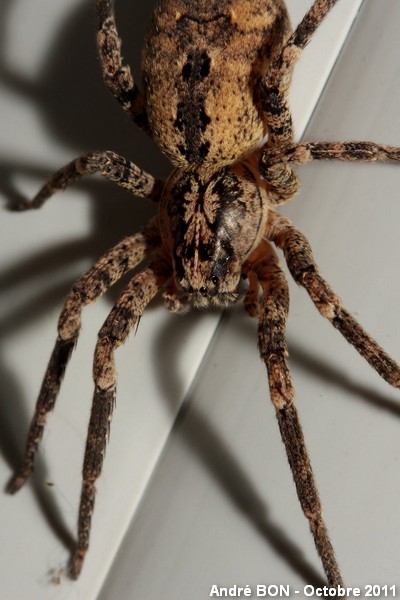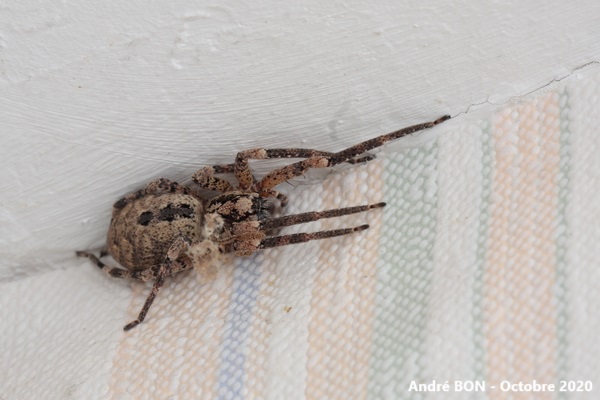




| Zoropsis spinimana (Dufour, 1820) |





|
|
Scientific name: Zoropsis spinimana (Dufour, 1820) Common name: French name: Zoropse à pattes épineuses Order: Araneae Family: Zoropsidae Size: 15 to 21 mm for females, 10 to 12 mm for males. Biotope: Woodland edges, open woodlands, under tree barks or under stones. This spider often enters into human buildings, especially in the northern part of its range, so that it is protected from the cold. Web: No web. Observation period: Adults are mature in autumn and they are observed until spring. At this time females lay their eggs and sit on the cocoon in some kind of a silken retreat. Geographic area: Mediterranean Europe, expanding northwards and eastwards (London, Switzerland, Austria, Central Europe to Russia), North Africa. Introduced to the United States of America in the region of San Francisco. |
You can recognize the spiders of the Zoropsis genus by the pattern marking the upper size of their cephalothorax. Some people say that it resembles the mask of Nosferatu. The median area of Zoropsis spinimana's cephalothorax is mainly covered with pale hairs. It is bordered by dark bands preceding a lighter-coloured peripheral zone. The abdomen shows a black cardiac patch appearing as the merge of two or three very large black spots. You can also generally see an alignment of chevrons at the rear of the cardiac patch. The tip of the fore legs is very dark. The chelicerae are black. Zoropsis media which, is only found in south-western Europe (only in the southern regions in France), is a smaller size. It shows less contrasted markings. Its fore legs are a lighter colour and its chelicerae are reddish. |
| [To know more about the Zoropsis spinimana] [Next picture] [Top] |

|
Here is one spider for which it is easy to determine the species it belongs to. I have observed it on a stationary cabinet's door in my garage. It was walking, during the night, attached to a silken thread, looking for potential preys. A simple measure of the width of one stripe on the cabinet's door permitted me to precisely evaluate the spider size (abdomen + cephalothorax) : 21.6 mm (This is longer that what I have found in books). |
| [To know more about the Zoropsis spinimana] [Next picture] [Previous picture] [Top] |

|
I have tried to shoot a picture in front of the head to see how the eyes are positioned. The result is not really easy to analyse. I have read that the eye arrangement is very similar to the one of the Pisauridae family. |
| [To know more about the Zoropsis spinimana] [Next picture] [Previous picture] [Top] |

|
I am observing Zoropsis spinimana more and more often. Is this a sign of the northward expansion of this species? |
| [To know more about the Zoropsis spinimana] [Next picture] [Previous picture] [Top] |

|
This time I succeeded in shooting a front view so that you can see the eye pattern. |
| [To know more about the Zoropsis spinimana] [Previous picture] [Top] |

|
The Tegenaria (now classified as Eratigena) that used to take refuge in the house in the autumn have practically disappeared. They have been replaced by Zoropsis spinimana. |